
Old Japanese house.
Details and larger version

The traditional Japanese home is a thing of beauty. Exposed post and beam construction supports intricate roof tiles, wooden ceilings, tatami (woven straw mat)-covered floors, and shoji (rice-paper screen)-covered windows. Using natural materials and constructed by hand, these structures are sympathetic to the environment and are at one with the landscape.
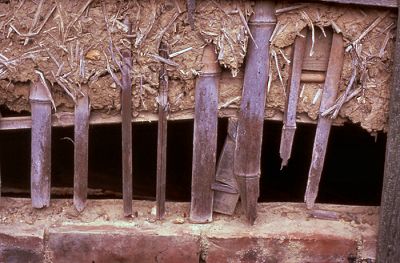
|
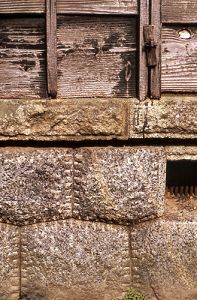
|
|
|
Japanese version of lath-and-plaster.
Details and larger version |
Old stone foundation.
Larger version |
Nowadays, pre-fab and American-style homes using synthetic materials dot the landscape of Japan. But when Mitsuyasan built his new home, he went traditional. What a beautiful backdrop this structure makes for his bonsai nursery.
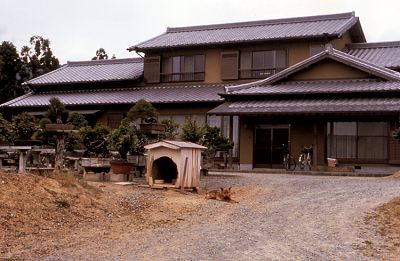
Enter the front door and you are at a ground-level vestibule. After removing your shoes, you step up to the house. Failure to leave shoes at the front door is unforgivable – one of the few mistakes I didn't make while apprenticing. Slippers, socks, or just bare feet are acceptable inside the house – until you enter the bathroom. A special pair of bathroom slippers is at the door. You're supposed to put them on as you enter and drop them off as you exit, but I don't want to admit the number of times I waltzed through the house wearing them.
Another aspect of the traditional Japanese home is the lack of heating and air-conditioning. During the winter months, when temperatures would drop into the twenties, kerosene heaters were placed in Mitsuyasan's living room and workshop.
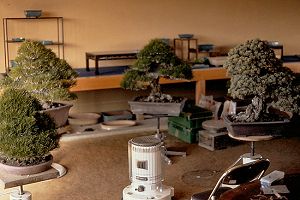
These two rooms and the ofuro (soaking tub) were my favorite places to spend waking hours because the rest of the home wasn't much warmer than the outside. It was a shock to head to bed and see my breath in the chill. I slept on a futon (a twin-sized quilt placed on the tatami mat) with the covers up to my nose. The morning temperature was so cold that I quickly learned how to dress while in the futon. Thank goodness for one Japanese innovation: heated toilet seats.
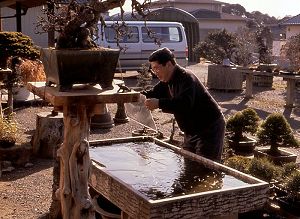
|
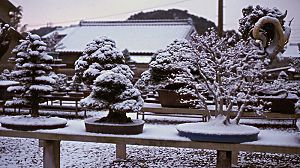
|
|
|
Mitsuyasan removing a sheet of ice from the fish basin. Larger version |
The nursery, dressed in white.
Details and larger version |
And then there were the summer months. A fan was plugged into each room, but blowing around hot, humid air wasn't very comfortable. By 7:30 am I was dripping. After breakfast and before heading to the workshop, I would often stop off at my room, plant my torso one foot from the fan, and cool off. Within ten minutes of exiting the room, I was a hot, soggy mess again. And that was only in July; August was even hotter.
Fortunately, I was apprenticing with a considerate sensei (teacher). Mitsuyasan sent me home to the mild, dry climate of Los Angeles for the month of August. The only work done on bonsai that month was keeping them hydrated. After thoroughly watering all trees, Yochan went to the house to hydrate himself. After a break, he went back out to spray the foliage and cool down the pots. This routine was repeated throughout the day for the entire month.
According to Yochan, ninety percent of the time a tree is in ill health, the problem started in the root system. If the soil dries out, roots will shrink. Then when rehydrated, the roots swell. Repeated shinking and swelling of roots will lead to cracks which can allow disease to invade.
Good and consistent watering techniques result in healthy, vibrant bonsai. The best time to water trees is in the morning. The goal is for the root system to stay evenly moist throughout the day. It's not that difficult to do when you have a couple of apprentices studying and living on the premises. In Japan, there's always someone around to water the trees.
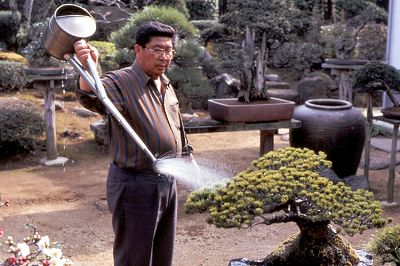
The frequency of watering depends on the size of tree, amount of sun or shade, temperature, etc. The porousness of the soil also greatly affects water retention.
Heavy soil made up of fine particles tends to stay soggy and is therefore watered less often. But while the bottom third of the soil in the pot is still wet, the rest of the soil is drying out. The roots reach for the bottom of the pot looking for more consistent moisture and temperature. This inhibits development of nebari (surface roots) and can also cause instability in the tree.

Porous, well-draining soils dry out faster than heavier soils, but are easier to keep evenly moist. During the summer months, additional spritzing of the foliage and the top layer of soil is needed at least once or twice a day. Midday waterings will not just moisten the soil but will also help create fabulous nebari. Feeder roots will search for food and water. If the right conditions exist, not only the rootage but also the lower trunk will thicken.
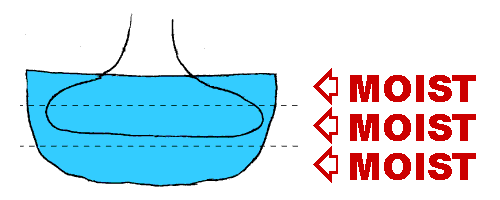
Watering a tree may not seem so important or interesting. But as Mitsuyasan taught me, correct hydration results in much more than just a healthy bonsai. Stability, radiating nebari, and trunk taper are desirable results of proper watering.
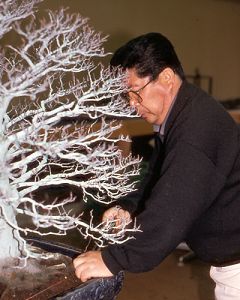
|
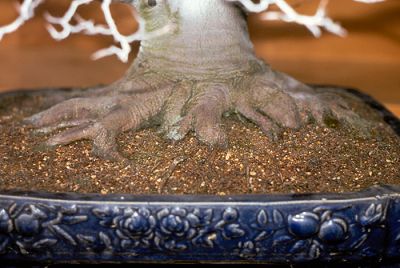
|
|
|
Mitsuyasan repots a large beech.
Details and larger version |
The nebari.
Details and larger version |
[ Top of page | Go back | Go forward | "An Apprentice in Japan" contents | Site contents | Home | ]